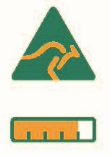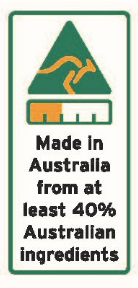Labelling
Australian consumers now have much greater certainty about the origins of the food they buy, due to the introduction of mandatory Country of Origin food labelling.
 | The familiar green and gold kangaroo logo will only be found on food products that were grown, produced or made in Australia - allowing you to quickly identify the food's Australian origin. The bar chart show you the minimum proportion of Australian ingredients in the food. |
 | ‘Grown in’ is a claim about where the ingredients come from and where processing has occurred. The claim is commonly used for fresh food e.g. Fruit, veg, meat. |
 | ‘Produced in’ is a claim about where the ingredients come from and where processing has occurred. This claim is often used for processed, as well as fresh foods. |
 | ‘Made in’ is a claim about the manufacturing process involved in making the food. This can include food with no ingredients from Australia. |
 | ‘Packed in’ claims are used for foods that contain ingredients from multiple countries and can’t claim to have been grown, produced, or made in Australia or any other country. |
Manufacturers, processors and importers that offer food for retail sale in Australia need to comply with the Country-of-Origin Food Labelling Information Standard, which specifies how claims can be made about the origin of food products.
There is different labelling requirements for ‘priority’ and ‘non-priority’ foods. A product is a non-priority food if it belongs to one of the following categories and are only required to carry a text statement about where the food was grown, produced, made or packed.
- seasoning (e.g. salt, spices and herbs)
- confectionery (e.g. chocolate, lollies, ice cream, popcorn)
- tea and coffee (in dry, or ready to drink, form)
- biscuits and snack food (e.g. chips, crackers and ready to eat savoury snacks)
- bottled water
- soft drinks and sports drinks
- alcohol
Everything else is a priority food. For example, priority foods include fruit and vegetables, meat, seafood, bread, milk, juice, sauces, honey, nuts and cereal.
Labels will vary depending on the type of food and whether it was grown, produced, made or packed in Australia.
The familiar green and gold kangaroo logo is only allowed to be used on foods that were grown, produced or made in Australia. This will allow consumers to quickly identify foods with authentic Australian origin. The new labelling system also allows consumers to easily and quickly identify the percentage of Australian ingredients along a segmented bar chart and also written clearly below. Below the bar chart there is also the statement declaring any of the following, ‘grown in’, ‘produced in’, ‘made in’ or ‘packed in’.
The Australian Competition and Consumer Commission (ACCC) will conduct market surveillance checks to ensure businesses are correctly displaying the new labels. Country of Origin Food Labelling Standard sits under the Australian Consumer Law (section 134).
Key Facts about the Laws
- Most food that is made, produced or grown in Australia will need to carry a label that also includes a kangaroo symbol, as well as text and a bar chart indicating the percentage of Australian ingredients.
- Labels for most products packed in Australia that contain imported foods which have undergone no or only minor processing in Australia will carry a ‘packed’ statement, as well as text and a bar chart indicating the percentage of Australian ingredients. They will not carry the kangaroo symbol.
- Imported food will continue to show where it was grown, produced, made. If the food was not grown, produced or made in a single country it will need to indicate where it was packed and that it is of multiple origins or comprises imported ingredients.
More Information
Information on what the new labels will look like and how to get started is available on the Australian Government’s Business website. This includes a Country of Origin Labelling online tool.
The Country-of-Origin Food Labelling Information Standard 2016, section 134 of the Australian Consumer Law, can be found here.
Extensive information about Food Labelling can be found on the ACCC website:
For Businesses
For Consumers
Egg Labelling
The Commonwealth Government has introduced an Information Standard under the Australian Consumer Law (ACL) for all egg producers that prescribes their obligations when promoting or selling free range eggs. The Information Standard applies from 26 April 2018. The standard informs consumers and the public more generally about free-range egg claims which will enable the public to have confidence and make informed choices when buying free range eggs.
The ACL places an obligation on traders not to mislead consumers in promoting their goods and services therefore any claims that eggs are “free range” means they must come from hens that a reasonable consumer would consider are produced in a free-range environment.
For more information, please refer to the Fact Sheet or the Standard itself.
Egg Labelling Factsheet PDF (250.0 KB)
ACL (Free Range Egg Labelling) Information Standard 2017